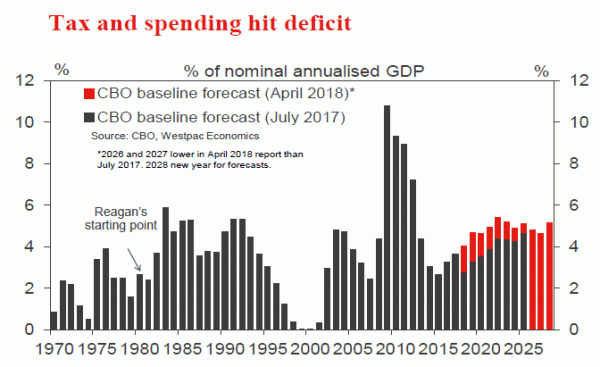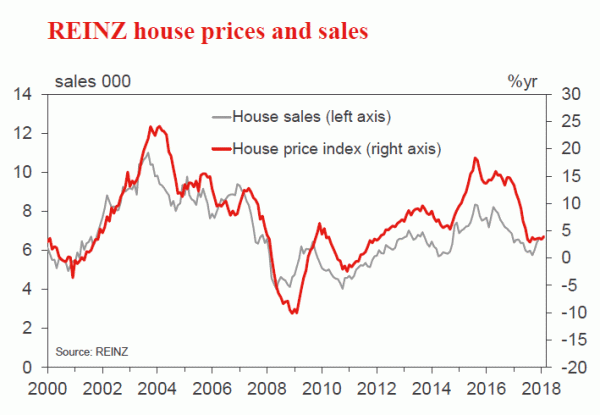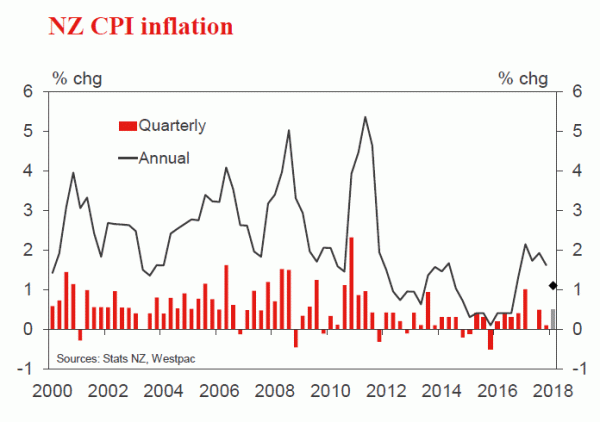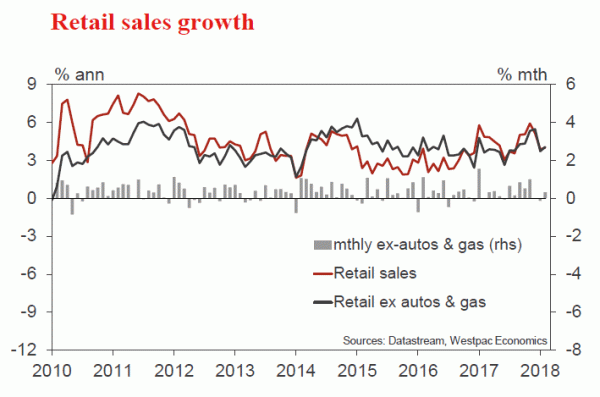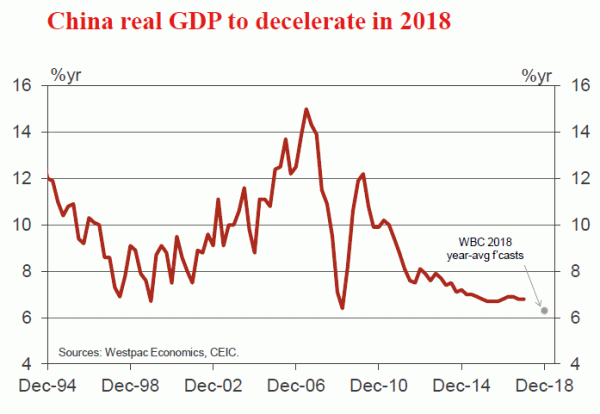Week beginning 16 April 2018
- RBA Financial Stability Review – global risks dominate.
- Australia: Westpac-MI leading index, RBA minutes, employment.
- NZ: CPI, house sales.
- China: GDP.
- Euro Area: consumer confidence, ZEW survey.
- US: retail sales, Federal Reserve Beige Book.
- Canada: BoC decision
- Key economic & financial forecasts.
Information contained in this report current as at 13 April 2018.
RBA Financial Stability Review – Global Risks Dominate
The Reserve Bank released its semi-annual Financial Stability Review (FSR) this week. While previous reports have singled out domestic concerns that led to significant policy changes – the ‘macro-prudential’ tightenings in 2015 and 2017 – the current focus is more around risks from abroad. Foremost amongst these is the potential disruption from a sharp rise in global interest rates. Threats stemming from China’s financial system again highlighted but recent developments are seen as positive. To the extent that Australia’s household debt levels are mentioned, they are characterised as a ‘contingent risk’ that could amplify a shock with borrower stress still low and regulatory measures improving the risk profile of new loans.
The RBA’s FSR assesses the condition of the financial system and potential risks to financial stability. While the report may not have the direct link to monetary policy decisions the quarterly Statement on Monetary Policy has, it nonetheless sets out some of the Bank’s key concerns, some of which can factor in policy decisions and wider policy formation. Most notably, concerns around Australia’s high household debt levels have influenced the Bank’s interest rate decisions in the past and prompted so-called ‘macro-prudential’ tightening measures in both 2015 and 2017.
The circumstances leading in to the April FSR look considerably more benign on the domestic front. In particular, the housing market backdrop is decidedly soft and a far cry from the strong gains in 2015 and 2017 that were sparking concerns about potential overheating. Dwelling price growth nationally has been flat over the last year with modest declines over the last six months. That compares to the double-digit growth rates ahead of the key reviews in 2017 and 2014.
Instead the focus of the report this time is more around the potential risks associated with shocks from abroad, the primary concern being the potential vulnerability to a global interest rate shock. More specifically, a “sharp rise in interest rates in the absence of stronger economic growth arising from, for instance, a jump in realised or expected inflation or a change in investors’ risk appetite”. The Bank has highlighted in the past the extended period of very low interest rates and low volatility and the extent to which high asset prices relied on the expectation that this situation would continue. This concern has clearly been sharpened by the market turbulence in February – sparked in part by a surprisingly strong wage inflation read in the US and a shift in Fed expectations that saw rates rise across the curve.
The risk of similar episodes is highlighted as a key stability concern with global debt levels high and the potential for a shock to be amplified by more leveraged household and corporate sectors in many countries. In a separate box, the Bank highlights the risk to the global financial system from associated asset price falls. The central concern is that the run-up in asset prices has been across a wide range of assets and a synchronised fall could be very disruptive, notwithstanding post-GFC improvements to the resilience of the global financial system architecture.
Importantly, the RBA’s fear centres mostly on a situation in which global interest rates rise sharply without a related increase in growth. While some of the market reassessment in February could be seen this way, the more general rise in rates has been accompanied by more positive expectations for growth and the prospects of a problematic rise in US inflation that might drive such a sharp move in rates still look remote.
On China, the RBA remains concerned about its financial system but notes some improvement over the last six months. The main issue continues to be around high corporate debt, the poor quality of some lending, and the complex and opaque nature of some parts of the financial system. Recent reforms and political commitments are seen as having had some success in containing a further build up in risks but further progress is needed.
On the domestic front, concerns around housing have clearly eased although high household debt is still viewed as a source of vulnerability in the event of a shock. Macro-prudential measures are viewed as having positively reduced the build-up of risks. Current indicators continue to show few signs of stress. Notably the Bank is sanguine on the potential stress from ‘interest only’ rollovers – “the share of borrowers who cannot afford higher P&I repayments and are not eligible to alleviate their situation by refinancing is thought to be small”.
It is also relatively sanguine on risks in the business sector. Although commercial property is still seen as an area to watch, the bank notes that increases in apartment supply have been absorbed well so far despite some increase in settlement issues. Regulatory measures have also seen Australia banks tighten lending criteria for commercial property although foreign banks have become more active. Again, a further increase in global interest rates could impact valuations, leading to some increase in stress.
More generally, Australian banks are seen as having improved their resilience and performance. The RBA notes the ‘spike’ in short-term funding spreads – BBSW is up about 25bps since the start of the year despite little change in cash rate expectations. While they note historically this has been an indicator of market stress or credit risk, the current circumstance “appears instead to be due to changes in the demand for and supply of US money market instruments” which have spilled over to Australia. The increased issuance of treasury bills on the back of the suspension of the US government debt ceiling as well as near-term seasonal factors has combined with impacts from recent US tax changes encouraging US corporates to repatriate offshore funds and also to borrow directly in the US rather than via interoffice parents.
In terms of overall wholesale funding costs, the RBA also notes that long-term financing conditions remain favourable and that with reduced rates on deposits, “overall funding costs for Australian banks declined over the past year”.
Australian banks are seen as “resilient to potential domestic liquidity shocks” with both liquidity coverage ratios and net stable funding ratios above minimum requirements. Further analysis of bank’s interest rate risk to a 2ppt increase in shortterm rates is “modest, at around 2 per cent of their current capital level, which is much less than in many other countries”. Notably though, this resilience rests on the high share of variable rate assets – any shock is therefore passed on to borrowers, households in particular. How this may circle back to the banks through household activity becomes critical.
Conclusion
The RBA Board next meets on May 1. It is almost certain to leave rates unchanged and may well lower its 3¼% forecast for growth in 2018 in the May Statement on Monetary Policy released three days later. The FSR confirms that while domestic stability concerns around household debt and housing are less pressing than they were in 2015 and 2017 they are still a consideration for policy. The prime concern is instead the potential impact from rising global interest rates, particularly in an environment that does not see corresponding gains in growth and incomes and with some risk of large, synchronised asset price falls.
Asked following a speech this week “what keeps him awake at night?” the RBA Governor responded that he “sleeps relatively well” but his three main concerns were fragilities in China’s financial system, the possibility of a trade war, and the high level of household debt, particularly as it affects the economy’s response to an external shock. That suggests the Governor is less anxious, for now, than the FSR appears to be about a sudden sharp rise in global interest rates.
The week that was
Global markets have remained in a delicate balance this week, unsure of the next turn in the US/China trade saga and given growing geopolitical tensions. Meanwhile in Australia, the RBA sought to encourage optimism over the outlook.
For Australia, the most significant development this week was RBA Governor Lowe’s address in Perth, titled ‘Regional Variation in a National Economy’. His take-home point was simple: “over time the differences in the structure of output and employment across regions are tending to become smaller”. For much of the post-GFC period, Australia has suffered from a two (or more) speed economy, most evident after the end of the mininginvestment boom when opportunities in WA and Qld lagged a long way behind the other states.
However, as highlighted by Governor Lowe, this disparity of opportunity looks to be dissipating. Consider the 2.5%yr gain for employment in WA over the past year against the four years of no growth that preceded it. Business investment in the state has also stabilised over the past year, having halved from its peak. And business conditions are also trending higher towards those seen elsewhere in Australia. The one ‘cyclical’ convergence that is not positive for our economy is that of wages which are weak across the nation, restraining consumption.
Governor Lowe went on to discuss a number of structural factors across the states. Two are worth highlighting. First is interstate migration. While NSW and Vic has received the lion’s share of international migration, interstate migration is now spreading the benefit of population growth from NSW to Queensland. Further, the outflow of workers from WA has also abated. Both Qld and WA now have a stronger foundation for growth come 2018 and beyond. The imbalance in house prices also cited is a key justification of this outflow, with affordability weighing heavily on the minds of residents of NSW.
Interestingly, interstate migration remains a positive for Vic despite concerns over affordability. Arguably for Vic, the growth and employment opportunities there outweigh the high cost of living.
Providing support for the RBA’s optimism over the outlook, Westpac–MI consumer sentiment held above the optimist/ pessimist divide in April, near its long-run average. Economic conditions on a one and five-year view remain well above average levels despite recent trade and geopolitical tensions. But against this positive overview, households’ perceptions of their finances remain sub-par, particularly for the coming year. Consumers’ willingness to spend is then limited, with ‘time to buy a major household item’ also below average, and affordability concerns are felt all the more –most prominently in Sydney and Melbourne. It is difficult to foresee above-trend GDP growth in Australia if these concerns around family finances persist.
On business conditions, the exceedingly strong outcomes reported by the NAB business survey in January and February we were cautious of have now been reversed. That said, March was still a strong result, well above the long-run average. By sector, retail remains the standout weak spot, particularly given strength is relatively broad based elsewhere. This is a concern for business investment as equipment investment is typically concentrated in retail and other consumer-centric industries.
Moving offshore, developments in the trade spat between the US and China have been positive this week. President Trump’s request for another $100bn of Chinese imports to impose tariffs on was largely forgotten mid-week, thanks to President Xi’s conciliatory tone. In his address, President Xi provided nothing new in terms of policy, nor any hard dates for reform.
That said, President Xi’s remarks did (again) highlight that China is willing to negotiate a solution, even one that allows the US to claim an immediate political victory. China is instead focused on developing its long-term economic and financial strength; western know-how in finance and insurance (among other industries) could aid their cause materially. There is still a long way to go before the consultation period for tariffs announced to date ends. Further bouts of volatility before an eventual deal is therefore highly likely.
On US monetary policy, the March FOMC meeting minutes again emphasised that the Committee has a great deal of confidence in the outlook for the economy, and hence their ‘gradual’ approach to policy normalisation. We agree that the near-term risks are to the upside, but feel that, come mid-2019, that situation will turn. Strong outcomes in the short term will see financial conditions tighten, restricting growth later. To our mind, that will put a halt to the FOMC’s rate hike plans following four further increases by June 2019.
Chart of the week: US budget deficit
In the US, the CBO has released their long-awaited analysis of the Trump administration’s tax and spending initiatives – respectively passed in December 2017 and February 2018.
From 2019, the CBO’s best-case scenario sees the deficit at 5% of GDP, leaving public debt to GDP at 96% of GDP in 2028. Needless to say there are plenty of ways a worse outcome could come to pass. Most notably, given the current expansion is near the longest on record, a further decade of growth from here is highly unlikely. More so in 2019 than 2018, the risk of an eventual recession will play on market participants’ minds.
Further detail can be found in our Northern Exposure publication which provides regular analysis on the US and European economies.
New Zealand: week ahead & data wrap
Activity muddling along
For some time we’ve been highlighting that GDP growth over the next few years is likely to be slower than both the NZ Treasury and the RBNZ are assuming. We expect that growth is going to slow from rates of around 3.5% to 4% in recent years, to around 2.8% over 2018 and 2019. In part, that reflects some developments that are already underway, including increasing capacity constraints in the construction sector and a gradual slowdown of population growth from the current rapid pace. We also expect that the housing market will cool, putting a dampener on consumer spending.
With this in mind, the latest Quarterly Survey of Business Opinion provided some interesting reading. While business confidence has picked up as the uncertainty around last year’s election has faded, it remains lower than the levels we saw over the past few years. Importantly, both trading activity and forward orders remain down on the levels we saw through 2016 and early 2017. Overall, we’re left with a picture of an economy that is continuing to muddle along. However, we’re not seeing signs of the re-acceleration in activity that government agencies are banking on. And that’s also the message we’re getting from other surveys of business conditions, including the latest PMI.
Consistent with signs that the momentum in economic activity is softening, we’ve also seen some easing in businesses’ hiring intentions, and firms have reported less difficulty finding labour. However, at least at this stage, businesses’ investment intentions have been a bit more resilient than we might have expected.
On the prices front, we have seen a lift in cost pressures. However, this does not appear to be spilling over into widespread increases in consumer price inflation. In fact, looking at key sectors like retail, the number of firms who have been increasing their prices remains at low levels. Prices are rising a bit faster in the construction sector than elsewhere, but even here, things look like they are levelling off.
The impact of minimum wage hikes
This week we released two Bulletins looking at some key developments in the New Zealand economy. The first looks at the impact of planned minimum wage hikes.1 From the start of April the minimum wage increased from $15.75/hr to $16.50/hr. This was the first step in the new Government’s plan to raise the minimum wage to $20/hr by April 2021, economic conditions permitting.
Compared to other developed countries, minimum wage changes are likely to have a larger impact in New Zealand. That’s because, relative to average wage rates, New Zealand already has the highest minimum wage rate in the OECD. Planned policy changes will extend this lead further over the next few years.
Prior to the most recent increases, we estimate that around 8% of workers were covered by the minimum wage (around 155,000 people). The planned increases will likely cover around 10% more of workers. There will also be some workers who will receive a pay rise in order to maintain wage relativities across roles. This means that by April 2021, up to 25% of the workforce – about 530,000 workers – could have their pay rates affected by the increase in the minimum wage. However, the impact on labour costs will not be as dramatic, as these workers share of the total wage bill will be around 12%.
We estimate that the minimum wage hikes will add about 1 percentage point to the Labour Cost Index (LCI) over the next four years combined. That’s compared to what would have happened if the minimum wage had continued to rise at the same rate as in recent years. The minimum wage has been rising by around 3.3% per annum since 2011, which has added around 0.1% to the LCI each year. Over the coming years, the minimum wage will rise by around 6.2% per annum, and will have a larger impact in later years as increasing numbers of people are affected.
A 1% rise in the LCI as a result of minimum wage hikes is expected to reduce the number of hours worked by 0.3%, and raise the unemployment rate by 0.2%.
The impact on the CPI is expected to be much smaller than the increase in wage costs. Increases in the minimum wage are expected to add an additional 0.3 percentage points to the CPI, spread over the next four years. While some industries (such as hospitality) may increase prices due to minimum wage changes, competitive pressures are keeping a cap on many prices. In addition, in many affected industries, there is not a close relationship between wage costs and the prices faced by consumers (e.g. health care services).
Auckland’s growing housing shortage
The second Bulletin we released looks at Auckland’s growing housing shortage.2 Population growth in Auckland has continued to outpace home building, and around a decade of strong construction activity will be required. That is going to be a tough task to achieve. Auckland already has a shortage of around 30,000 homes, and the region’s population is set to grow by around 300,000 people over the coming decade.
We expect that construction activity will increase over the next few years. However, it will be a slow grind higher. Even with building levels still below the required pace, the construction sector is already encountering growing pains, including a shortage of skilled labour. This is providing a brake on how quickly construction activity can ramp up, and means that home building will need to remain strong even as population growth slows.
The shortage of housing is going to get worse before it gets better. Although we expect that population growth will slow over time, it will be several years before building levels catch up, and even longer for the shortage of homes to be eroded.
Data Previews
Aus Mar Westpac–MI Leading Index
Apr 18, Last: +1.30%
The six month annualised growth rate in the Leading Index rose from +0.68% in January to +1.30% in February, a well above trend read indicating improving prospects for growth in the first half of 2018. That said the index has been very choppy over the last four months, mainly reflecting volatile swings in the dwelling approvals component.
The Mar read looks likely to see some easing. It will include weaker updates on: the ASX200, down –4.3% vs –0.4% last month; the Westpac-MI Consumer Expectations Index, down –0.9% vs –0.1% last month; dwelling approvals, down –6.2% vs 17.2% last month; the yield spread, which has narrowed 30bps vs a 13bps widening last month; and the Westpac-MI Unemployment Expectations Index, which deteriorated 3.1% vs 1% last month. These moves will likely dominate small gains in total hours worked, US industrial production and commodity prices.
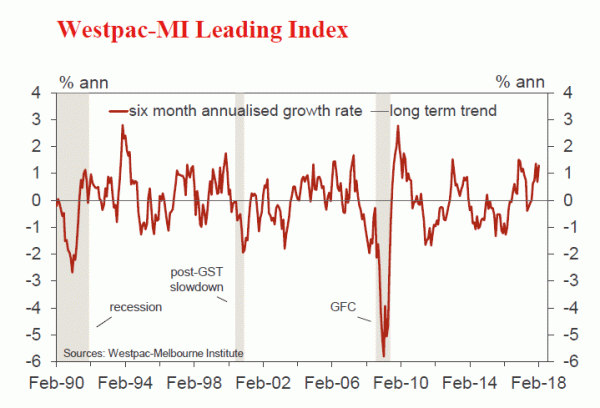 Aus Labour Force Survey – total employment ‘000
Aus Labour Force Survey – total employment ‘000
Apr 19, Last: 15.8k, WBC f/c: 20k
Mkt f/c: 20k, Range: 10k to 30k
Total employment grew 17.5k in February, broadly in line with the market expectation of 20k and a little below Westpac’s forecast of +25k. Full time employment rose 65k and part-time fell 47k reversing January’s mix of -53k and +66k respectively. Hours worked gained 1.2% in February after falling 1.3% in January.
2017 was a strong year for employment ending the year at a 3.4%yr pace. But momentum steadied over the past three months and the three month annualised pace has slowed to 2.1%. This pace is more consistent with a solid, rather than aggressive, employment growth outlook over the near-term as suggested by business surveys.
The business surveys have flattened a little but are still holding very robust levels suggesting healthy employment growth. Our 20k forecast will see the annual pace of employment growth ease modestly to 3.2%yr.
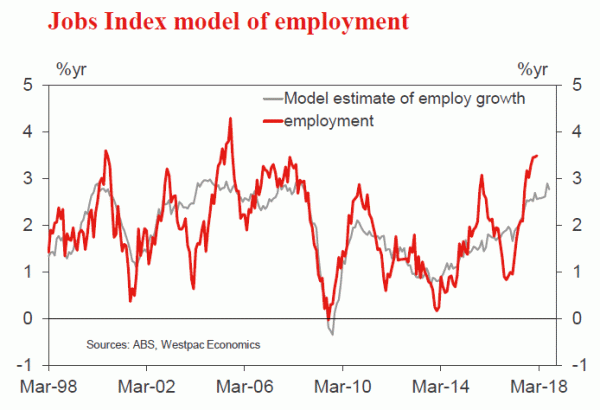 Aus Labour Force Survey – unemployment rate %
Aus Labour Force Survey – unemployment rate %
Apr 19, Last: 5.6%, WBC f/c: 5.6%
Mkt f/c: 5.5%, Range: 5.4% to 5.6%
In February the unemployment rate lifted to a soft 5.6% (5.56%) from 5.5% (5.50%) in January. Over the first three quarters of 2017, we saw some progress in reducing the unemployment rate, falling from a peak of 5.9% in February to 5.5% in September. However, that has since stalled as the participation rate has steadily risen from 64.5% in September 2016 to 65.7% as at February, while employment momentum has recently eased.
We are looking for the participation rate to hold at 65.7% which given the current rate of working age population growth should see the labour force lift by 25.7k in the month. As such we expect the unemployment rate to hold 5.6% when rounded to one decimal place.
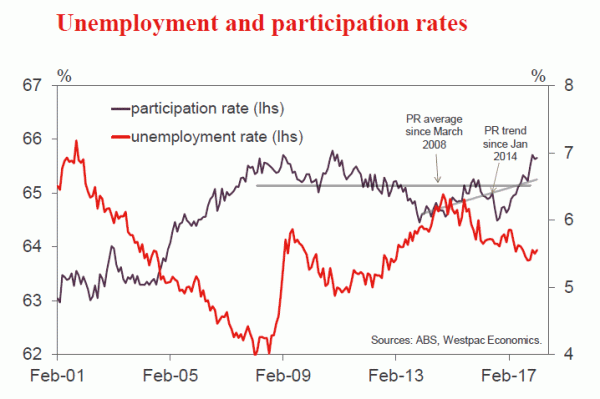 NZ Mar REINZ house sales and prices
NZ Mar REINZ house sales and prices
Apr 17, Sales last: +1.5%, Prices last: 3.9%yr
After slowing in early- to mid-2017, the New Zealand housing market has been more positive in recent months. House prices lifted 1.5% over the three months to February – slightly less in Auckland and Canterbury, slightly more elsewhere. Market turnover has also picked up, albeit less emphatically.
March will probably be another relatively buoyant month. Banks have been reducing mortgage rates and lending more freely.
However, later in 2018 we expect a marked housing market slowdown. The bright-line test for taxing capital gains on resold properties will be extended from two to five years, foreign buyers will be restricted from mid-year, and further tax changes designed to cool house prices can be expected. At the same time, population growth is slowing and fixed mortgage rates will soon stop falling.
Apr 19, Last: 0.1%, Westpac f/c: 0.5%, Mkt f/c: 0.5%
We expect a 0.5% rise in consumer prices for the March quarter, barring any major surprise in March food prices (released on Monday). This would bring annual inflation down from 1.6% to 1.1%, the lowest since September 2016.
There are two factors behind the drop in annual inflation. The first is the introduction of a years’ free tertiary education, which we estimate will take 0.2% off the CPI. The second is base effects: a surge in oil prices a year ago saw annual inflation rise to 2.2% in March 2017, before dropping back to 1.7% in June. The dip in annual inflation this year will be similarly short-lived.
Setting aside the expected volatility, underlying inflation remains subdued. The lower New Zealand dollar over the last year will add to tradables inflation, but domestic inflation pressures have yet to pick up.
Apr 16, last –0.1%, WBC 0.4%
US retail sales have continued to disappoint through Q1 2018. In the February report, a third consecutive negative was recorded for total sales.
It is certainly the case that one-off factors have been at play: auto sales continue to come back to a more normal level after their hurricane-induced spike in late 2017; also abnormally cold weather in February weighed on gasoline and store sales as consumers stayed home. However, a surge back in Mar is highly unlikely.
Evident in the income and savings data in recent months is that real wages growth (excluding the tax cuts) remains soft, and household savings low versus history. These restrictions on spending are unlikely to abate anytime soon. As such, we look for continued modest gains for spending through 2018 – circa 0.4% for headline sales in March, and 0.2% for core.
Apr 17, last 6.8%, WBC 6.8%
In the final quarter of 2017, annual growth was sustained at a strong 6.8% despite a pull back in the quarterly growth pulse, from 1.8% to 1.6%. The first quarter of 2018 looks as though it will be a repeat of the last (1.6%; 6.8%).
As we move through 2018, quarterly growth will be sustained near 1.6%, and that will result in the annual growth rate slowing to 6.3%, a little below authorities 6.5% growth target for the year.
Driving this outcome is expected to be a much-reduced contribution from net exports and continued modest momentum in investment, across both housing and infrastructure.
Evident from the PMI reports, restraint on hiring and incomes will preclude an acceleration in spending by the consumer. This trend will be sustained into 2019.




